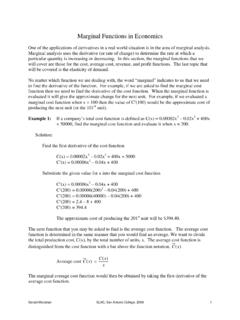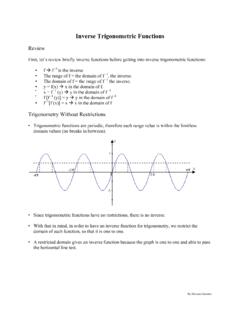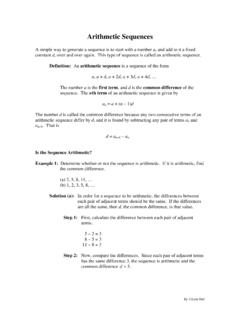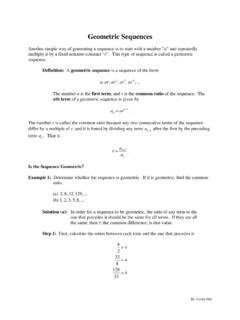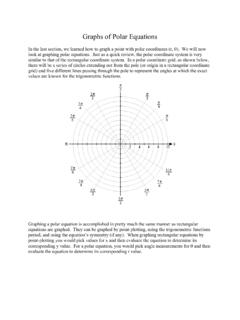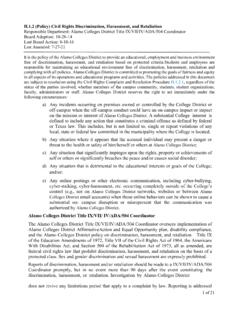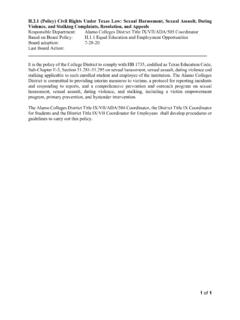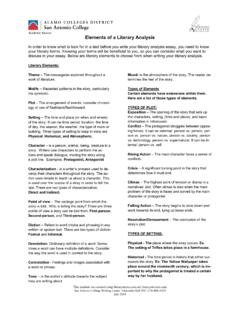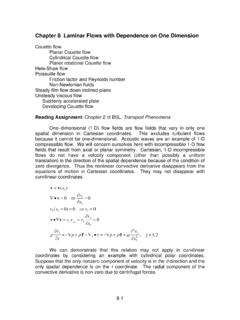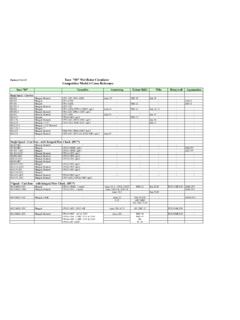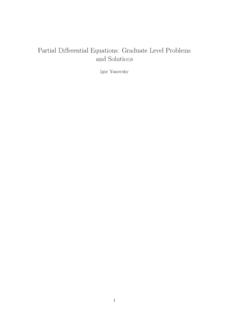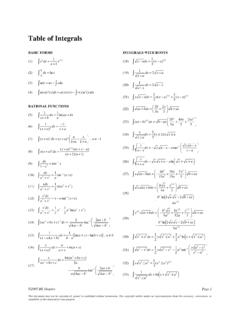Transcription of Dividing Polynomials; Remainder and Factor Theorems
1 Dividing Polynomials; Remainder and Factor Theorems In this section we will learn how to divide polynomials, an important tool needed in factoring them. This will begin our algebraic study of polynomials. Dividing by a Monomial: Recall from the previous section that a monomial is a single term, such as 6x3 or 7. To divide a polynomial by a monomial, divide each term in the polynomial by the monomial, and then write each quotient in lowest terms. Example 1: Divide 9x4 + 3x2 5x + 6 by 3x. Solution: Step 1: Divide each term in the polynomial 9x4 + 3x2 5x + 6 by the monomial 3x.
2 424 293569 3 563333xxxx x x3xxxx+ +=+ +x Step 2: Write the result in lowest terms. 42393565333333xxxxx2xxxx+ +=+ +x Thus, 9x4 + 3x2 5x + 6 divided by 3x is equal to 35233xxx+ + Long Division of Polynomials: To divide a polynomial by a polynomial that is not a monomial we must use long division. Long division for polynomials is very much like long division for numbers. For example, to divide 3x2 17x 25 (the dividend) by x 7 (the divisor), we arrange our work as follows. By: Crystal Hull The division process ends when the last line is of lesser degree than the divisor.
3 The last line then contains the Remainder , and the top line contains the quotient. The result of the division can be interpreted in either of two ways 23172533477xxxxx =++ or ()()231725734xxx x = ++3 We summarize what happens in any long division problem in the following theorem. Division Algorithm: If P(x) and D(x) are polynomials, with D(x) 0, then there exist unique polynomials Q(x) and R(x) such that P(x) = D(x) Q(x) + R(x) where R(x) is either 0 or of less degree than the degree of D(x). The polynomials P(x) and D(x) are called the dividend and the divisor, respectively, Q(x) is the quotient, and R(x) is the Remainder .
4 Example 2: Let P(x) = 3x2 + 17x + 10 and D(x) = 3x + 2. Using long division, find polynomials Q(x) and R(x) such that P(x) = D(x) Q(x) + R(x). Solution: Step 1: Write the problem, making sure that both polynomials are written in descending powers of the variables. 2323 1710xxx+++ By: Crystal Hull Example 2 (Continued): Step 2: Divide the first term of P(x) by the first term of D(x). Since 233xxx=, place this result above the division line.
5 Step 3: Multiply 3x + 2 and x, and write the result below 3x2 + 17x + 10. Step 4: Now subtract 3x2 + 2x from 3x2 + 17x. Do this by mentally changing the signs on 3x2 + 2x and adding. 22323 171032 15 Subtractxxxxxxx ++++ Step 5: Bring down 10 and continue by Dividing 15x by 3x. By: Crystal Hull Example 2 (Continued): Step 6: The process is complete at this point because we have a zero in the final row.
6 From the long division table we see that Q(x) = x + 5 and R(x) = 0, so 3x2 + 17x + 10 = (3x + 2)(x + 5) + 0 Note that since there is no Remainder , this quotient could have been found by factoring and writing in lowest terms. Example 3: Find the quotient and Remainder of 3431xxx2 + using long division. Solution: Step 1: Write the problem, making sure that both polynomials are written in descending powers of the variables. Add a term with 0 coefficient as a place holder for the missing x2 term. Step 2: Start with 3244xxx=.
7 Step 3: Subtract by changing the signs on 4x3 + 4x2 and adding. Then Bring down the next term. 2323224 14032 44 43 Subtract and bring down 3xxxxxxxxxx++ + By: Crystal Hull Example 3 (Continued): Step 4: Now continue with 244xxx = . Step 5: Finally, 1xx=. Step 6: The process is complete at this point because 3 is of lesser degree than the divisor x + 1.
8 Thus, the quotient is 4x2 4x + 1 and the Remainder is 3, and 32432344111xxxxxx = ++++. By: Crystal Hull Synthetic Division: Synthetic division is a shortcut method of performing long division that can be used when the divisor is a first degree polynomial of the form x c. In synthetic division we write only the essential part of the long division table. To illustrate, compare these long division and synthetic division tables, in which we divide 3x3 4x + 2 by x 1: Note that in synthetic division we abbreviate 3x3 4x + 2 by writing only the coefficients: 3 0 4 2, and instead of x 1, we simply write 1.
9 (Writing 1 instead of 1 allows us to add instead of subtract, but this changes the sign of all the numbers that appear in the yellow boxes.) To divide anxn + an-1xn-1 + .. + a1x + a0 by x c, we proceed as follows: Here bn-1 = an, and each number in the bottom row is obtained by adding the numbers above it. The Remainder is r and the quotient is b xbxb 0+++ + By: Crystal Hull Example 4: Find the quotient and the Remainder of 42762xxx +x using synthetic division. Solution: Step 1: We put x + 2 in the form x c by writing it as x ( 2).
10 Use this and the coefficients of the polynomial to obtain 21 0 7 6 0 Note that we used 0 as the coefficient of any missing powers. Step 2: Next, bring down the 1. 2076 1 1 0 Step 3: Now, multiply 2 by 1 to get 2, and add it to the 0 in the first row. The result is 2. 21 0 7 6 0 221 Step 4: Next, 2( 2) = 4. Add this to the 7 in the first row. 21 0 7 6 0 2 1243 By: Crystal Hull Example 4 (Continued): Step 5: 2( 3) = 6.

